Nos últimos anos, a tecnologia de separação por membranas tem sido amplamente estudada e aplicada como uma das novas tecnologias para tratamento de esgoto. Em comparação com outras tecnologias, como separação por gravidade, coagulação, quebra de emulsão, absorção e desnatação de óleo, biodegradação, adsorção por floculação, troca iônica e outros processos de separação convencionais, esta tecnologia tem muitas vantagens. Como forte seletividade, baixo consumo de energia, ampla gama de aplicações, equipamento simples e ecologicamente correto, fácil operação e assim por diante. A membrana de separação óleo-água pode ser dividida em membrana orgânica e membrana inorgânica de acordo com o material. A membrana orgânica tem uma ampla gama de aplicações em pesquisas científicas e áreas comerciais. Em comparação com a membrana orgânica, a membrana cerâmica inorgânica tem forte estabilidade química e térmica, excelente resistência à sujeira e à pressão, fácil de limpar, alta resistência mecânica, longa vida, portanto, o uso de membrana cerâmica para separação de emulsão óleo-em-água é um importante tendência. A modificação hidrofóbica pode aumentar a molhabilidade do filme cerâmico em óleo, melhorar a eficiência de separação da emulsão água em óleo e aumentar a estabilidade química e durabilidade do filme cerâmico.
A forma do sistema de emulsão água em óleo (A/O) é que a água é dispersa no óleo na forma de pequenas gotículas. A contaminação da membrana durante a separação da membrana leva à diminuição do fluxo de permeação e da taxa de retenção com a extensão do tempo de uso, o que encurta a vida útil da membrana e limita a aplicação da tecnologia de separação por membrana. A modificação da superfície da membrana cerâmica pode melhorar a seletividade específica e o efeito de separação da membrana, reduzir a interação entre a superfície da membrana e moléculas de alimentação desnecessárias e reduzir a poluição da membrana até certo ponto. Portanto, a separação de emulsões de água em óleo geralmente seleciona um filme hidrofóbico, que permite que as gotículas de óleo passem e retenham as gotículas de água usando as características hidrofóbicas e lipofílicas da superfície da membrana, de modo a obter o efeito de óleo-água separação.
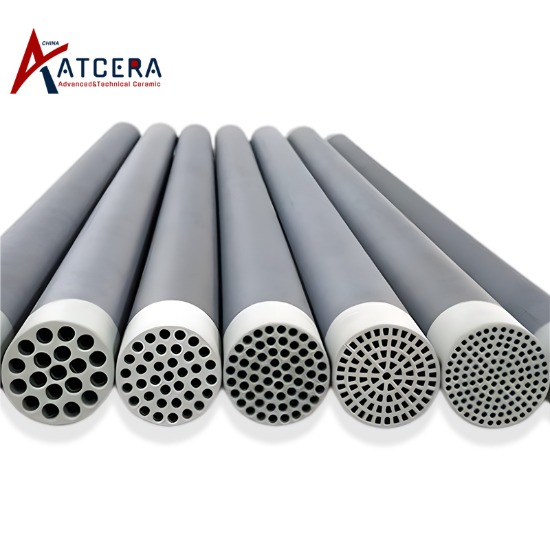
Modificação hidrofóbica da superfície da membrana cerâmica
A modificação hidrofóbica da superfície do filme cerâmico é geralmente obtida combinando ou aderindo materiais hidrofóbicos, selecionando uma energia superficial mais baixa, rugosidade e estrutura superficial apropriadas, como o uso de silano ou tiol para fornecer propriedades químicas superficiais, e a introdução de mícron ou nanoestrutura para obtenha uma superfície com melhor rugosidade, melhore o efeito hidrofóbico da superfície do filme e melhore o desempenho de separação.
Existem três métodos comuns para modificação hidrofóbica da superfície da membrana cerâmica: impregnação, sol-gel e deposição química de vapor.
01. Método de imersão
Impregnation method (Impregnation method) does not require special equipment, just the original ceramic film directly immersed in hydrophobic substance solution, the method is simple and direct, easy to operate, low cost. The hydrophobic modification of ceramic membrane surface is carried out by immersion method, which usually uses the functional group of hydrophobic substance to connect with the hydroxyl group on the ceramic membrane surface through condensation reaction.
Taking siloxane as a modifier for example, the operation steps of the impregnation method are as follows: dissolve the organosilane in water or ethanol and hydrolyze it to obtain a reactive silanol solution; When the pre-treated ceramic membrane is immersed in the solution, the reactive silane molecules can be adsorbed on the surface of the membrane, and the hydrophobic membrane can be obtained.
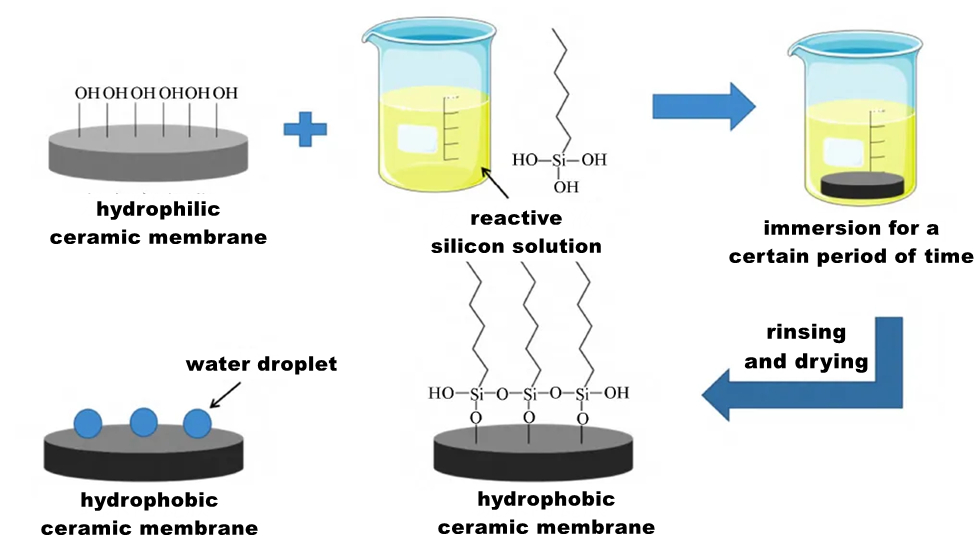
Hydrophobic effect is the result of the joint action of surface roughness and surface energy. In the study of hydrophobic modification of ceramic film, it is usually first to provide a certain rough micro-nano structure on the surface of ceramic film, and then modify it with low surface energy. In addition to the modification with silane coupling agent, mercaptan is also the preferred material to reduce the surface energy of the film.
In summary, the operation and steps of hydrophobic modification of the surface of ceramic film by impregnation method are relatively simple, and are greatly affected by the type of modifier, the concentration of modifier, the impregnation time, the number of impregnation times and the roughness of the surface of ceramic film. In addition, because the number of substances with low surface energy that react depends on its own concentration and the number of hydroxyl groups on the surface of ceramic film, Therefore, the method also has a great dependence on the reactive hydroxyl group on the surface of the ceramic membrane.
02. Sol-gel method
Sol-gel technique uses compounds containing highly chemically active components as precursors, and mixes these raw materials uniformly in the liquid phase. After chemical reactions such as hydrolysis and condensation, a stable transparent Sol system is formed in the solution. The sol is slowly polymerized among aged colloidal particles to form a gel with a three-dimensional network structure. The gel was dried and sintered to produce molecular and even nanostructured materials.
The hydrophobic modification of ceramic membrane by sol-gel method can form a large rough structure on the surface of the membrane, and can directly bind low surface energy chemicals. However, the early introduction of organosilane into the sol solution may lead to the formation of large volume polymers, resulting in poor modification effects.
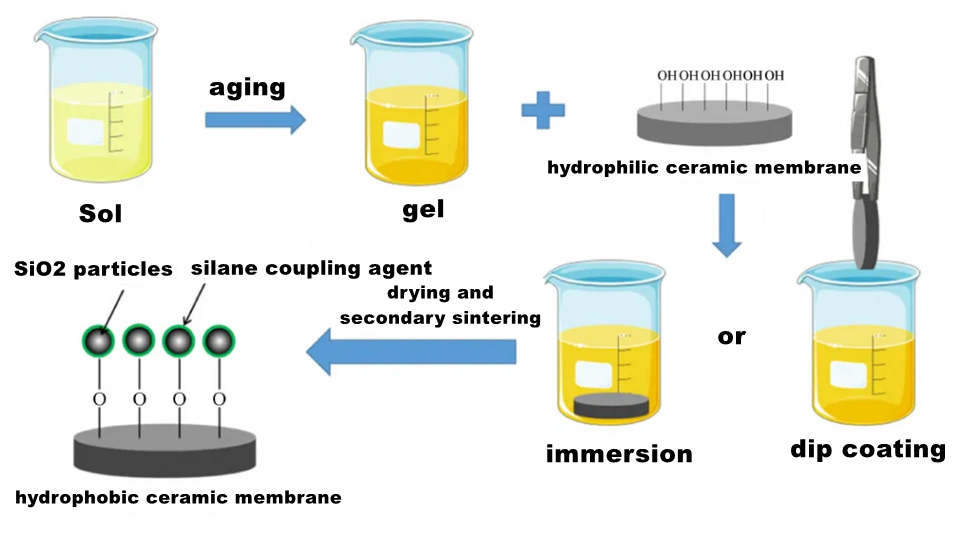
Compared with other methods, sol-gel method can prepare a stable hydrophobic surface with good separation effect, but it takes a long time to prepare the sol solution, and macromolecular polymers may be formed in the process, which affects the modification effect. In general, secondary sintering is required after the completion of coating, and the process is more complicated. In addition, excessive temperature during secondary sintering will destroy the structure of the film, reduce the hydrophobicity and stability of the film, and the aperture of the modified film will decrease with the increase of the number and time of sol-gel coating. In addition, the sol has an important effect on the formation of colloid in the process of colloid preparation, and then affects the film forming quality. Coating time and times, ambient temperature and humidity, heating rate, calcination temperature and calcination time all have a great influence on the subsequent coating drying process. At present, the process can be simplified by reducing the sintering steps at high temperature, forming a rough structure on the surface of the film at one time and combining with low surface energy materials, so as to reduce the damage of the film structure at high temperature.
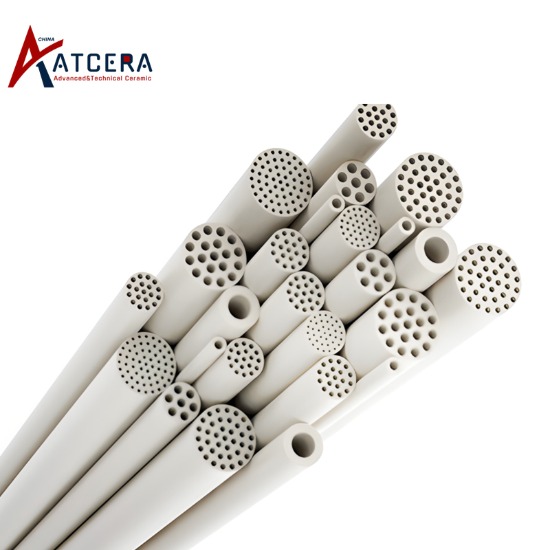
03 Chemical vapor deposition method
chemical vapor deposition (CVD) uses gas phase reactants deposited on the substrate surface to form a solid film with specific chemical properties. The method has the advantages of controllable film composition, good film repeatability, uniform film layer, wide application range, no restriction on the shape of the substrate and no damage to the substrate material, and is an effective method to change the surface properties and microstructure of the film. For hydrophobic modification of the ceramic film using this method, the ceramic film needs to be placed in a closed container and heated at the boiling point temperature of the organosilane for a long time. The organosilane vapor is passed through to react with the hydroxyl group on the surface of the ceramic film, and the reaction principle is the same as that of the impregnation method.
Under normal circumstances, in order to make the organosilane reagent can be fully utilized, it is necessary to select a closed container with a size similar to the ceramic membrane, so that the contact and reaction of organosilane vapor with the ceramic membrane can be maximized.
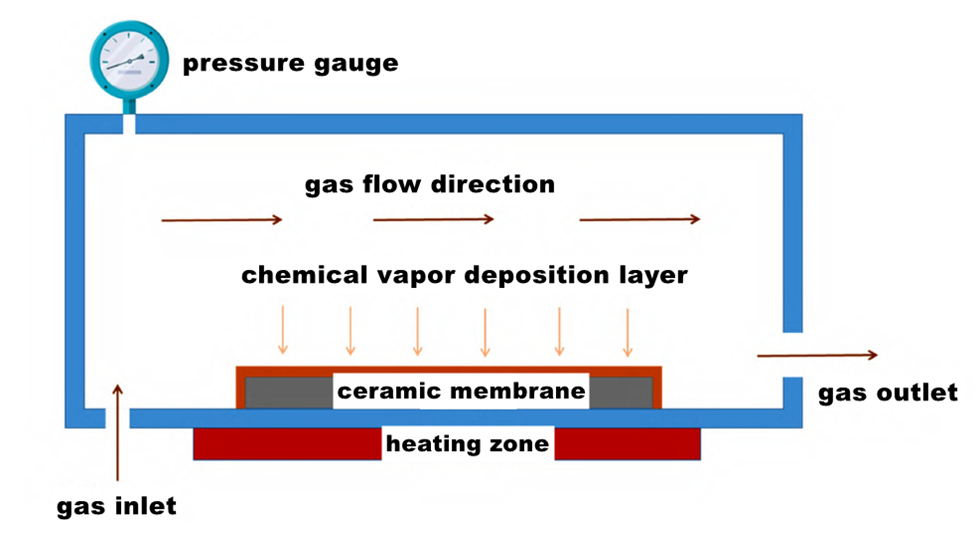
A deposição química de vapor (CVD) é o método preferido para preparar micro-nanopartículas e nanobastões na superfície do filme e formar a microestrutura ordenada. O filme cerâmico hidrofóbico modificado por deposição química de vapor tem as vantagens de uma camada de filme uniforme, boa estabilidade e ampla faixa de aplicação, mas ao mesmo tempo, a espessura do filme hidrofóbico é fina, as propriedades mecânicas são insuficientes e os defeitos como rachaduras e bolhas são fáceis de ocorrer sob impacto externo. Gotículas de água e poluentes penetram no filme através de rachaduras, destroem sua estrutura interna e reduzem a propriedade hidrofóbica e a estabilidade do filme. Alguns dos organossilanos envolvidos na reação de deposição são tóxicos e causarão danos ao corpo humano e ao meio ambiente. Além disso, a temperatura de reacção exigida por este método é elevada e o consequente elevado consumo de energia e elevado custo limitam a sua aplicação na produção industrial real.





























